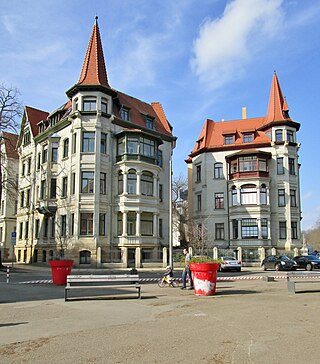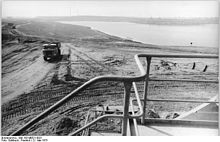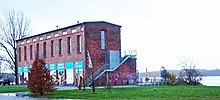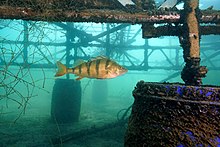
Markranstädt is a town in the Leipzig district, in Saxony, Germany. It is situated 11 km southwest of the city of Leipzig and has close to 15,000 inhabitants.
Leipziger Verkehrsbetriebe GmbH operates one of Germany's largest tramway networks. The tramway network history is presented below in tabular form, including opening, electrification, and closing dates by segment. Street names of the time are used in the tables, with current names in (parentheses).
Ernst KarlErdmann Heine was a lawyer in Leipzig and a major entrepreneur and industrial pioneer who shaped the face of the western suburbs of Leipzig.

RasenBallsport Leipzig e.V., commonly known as RB Leipzig, is a German professional football club based in Leipzig, Saxony. The club was founded in 2009 by the initiative of the company Red Bull GmbH, which purchased the playing rights of fifth-tier side SSV Markranstädt with the intent of advancing the new club to the top-flight Bundesliga within eight years. The men's professional football club is run by the spin-off organization RasenBallsport Leipzig GmbH. RB Leipzig plays its home matches at the Red Bull Arena. The club nickname is Die Roten Bullen.

Waldstraßenviertel, is a neighbourhood in the north west of Leipzig's borough Mitte in Saxony, Germany. It is considered one of the largest complete areas of Gründerzeit buildings in Europe and is therefore considered of important cultural and heritage status. Many of its buildings are therefore protected or listed.

Lindenau is a locality of Leipzig, in Saxony, Germany. It is part of the Stadtbezirk (borough) Alt-West.

The Mitteldeutsche Zeitung is a regional daily newspaper for southern Saxony-Anhalt, Germany. Published in Halle with several local versions, the paper is owned by M. DuMont Schauberg, Cologne.

Mitteldeutschland S-Bahn, lit. 'Middle Germany S-Bahn', represents an enlargement of the previous Leipzig-Halle S-Bahn. It is an electric rail public transit system operating in the metropolitan area of Leipzig-Halle, Germany. This S-Bahn network developed from two separate S-Bahn networks of Halle (Saale) and Leipzig, which were established separately in 1969 and then linked in 2004. With the opening of the Leipzig City Tunnel on 15 December 2013 as a new artery, the network was extended for the first time to the federal states of Thuringia and Brandenburg. With a system length of 802 km (498 mi), it is the largest S-Bahn network in Germany, displacing the long-time title holder Rhine-Ruhr S-Bahn from that position. The locomotive-hauled double-decker trains partly dating back to the DDR-era have been largely replaced by electric multiple unit Bombardier Talent 2 trains, but some older trains are still used during rush hour.

The Leipzig Bay(German: Leipziger Tieflandsbucht) or Leipzig Basin or Saxon Lowland or Saxon Bay is a very flat, originally lakeless and highly fertile plain in Central Germany, in northwestern Saxony and southeastern Saxony-Anhalt, anchored by the foothills of the Harz mountains in the northwest and of the Ore Mountains in the southeast.

The Bundesstraße 87 is a Bundesstraße in Germany. It begins in Ilmenau and ends in Frankfurt (Oder). In Thüringia it runs partly along the Straße der Romanik.

Bertzit Tower is an investment ruin in the north of Kahla, which belongs to Plessa in the southern part of Brandenburg, itself part of the Elbe-Elster region.
Association football club RB Leipzig-affiliated teams include a reserve team, women's team, and junior and academy teams.

The Adlergestell in the Berlin district of Treptow-Köpenick is the longest road in Berlin at 11.9 kilometers. It runs from the district of Niederschöneweide to the district of Schmöckwitz on the southeastern outskirts of the city. The Berlin–Görlitz railway runs parallel to the Adlergestell.

The Inner City Ring Road in Leipzig in the district of Mitte is the ring road around Leipzig's city centre. It encloses the just 0.7 km2 (0.27 sq mi) large area of the old town without the former Vorstadts.

The Cospudener See is an artificially constructed lake situated directly on the southern outskirts of Leipzig, Germany. Leipzig, Markkleeberg and Zwenkau have shares in the lake which is on the site of a former open cast mine. The lake is popularly known as "Cossi", more rarely "Cospi", and has become highly popular with the local population, with long stretches of sand beaches and with a sauna directly located at the lake. There is also a small sailing harbor. The lake is a part of the Central German Lake District.

The Zeppelin Bridge is a road and tram bridge over the Elster basin in Leipzig. It connects the districts of Mitte and Altwest. It is under monument protection.

The Karl Heine Canal is an approximately 3.3 km (2 mi) long artificial watercourse in the west of the city of Leipzig in Germany and connects the Lindenau harbor with the White Elster River. It is spanned by 15 bridges and is navigable with small boats. The canal is under monument protection as a monument preservation entity “canal, bank reinforcements and bridges”.

The Mädler Arcade Gallery is the last completely preserved historic shopping arcade covered by an end-to-end glass roof in the city center of Leipzig. It is a facility of upmarket retail, restaurants, offices and cultural establishments.

Grünau [ɡʁyˈnaʊ̯] is a large housing estate in the western part of Leipzig, Germany, designed in the 1970s and 1980s. It dominates the Stadtbezirk Leipzig-West. In its short history Grünau was at times the most populated district of Leipzig with a maximum of 85,000 inhabitants (1989).

Bodies of water in Leipzig are the rivers White Elster, Pleiße and Parthe as well as numerous streams with the Leipzig Riverside Forest in Leipzig, Germany. Many of these watercourses have been diverted, canalised or drained for economic use, to defend the city and to protect against flooding, and new ditches and canals have also been built. A large number of ponds and lakes have also been created for fish farming, for urban planning reasons or as a result of open cast mining.






















